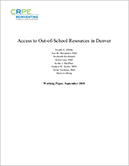This project, conducted in collaboration with the University of Washington’s Data Science for Social Good program, analyzes data from ReSchool Colorado’s work on summer opportunities through their “Blueprint4SummerCO” platform. The online platform is designed to give families a simple way to gain information about summer programs for their children. Programs can be searched by category (academics, arts, nature, sports, etc.), cost, location, and other program-specific characteristics. While the platform itself is meant to increase access, this research aims to understand the true supply and demand of summer programs for students in Denver.
This working paper explores the following questions:
- Which areas (neighborhoods, census block groups) of Denver have the lowest / highest access to summer programs?
- How does access to summer programs correspond with other public resources (e.g., libraries, parks, etc.)?
- How does access to programs correlate with student demographics and characteristics? And how does this relate to equity of access?
We find that white families are much more likely to be located in neighborhoods with high access to out-of-school programs, while Hispanic families are far more likely to live in Census block groups that have low access to these same opportunities. When we look numerically at index scores for each racial group, we see that black families are consistently located in neighborhoods with the lowest access to all types of out-of-school opportunities. Conversely, white families have the highest access to every type of program except for nature programs. Parks, fields, and libraries were all evenly distributed throughout Denver, unlike summer programs.
This kind of assessment is the first step that cities can take to better understand the enrichment gaps that exist between student groups. Finding solutions to help fill the gaps will likely require creative thinking by school and community leaders. But it may ultimately help reduce the achievement gap as well.




